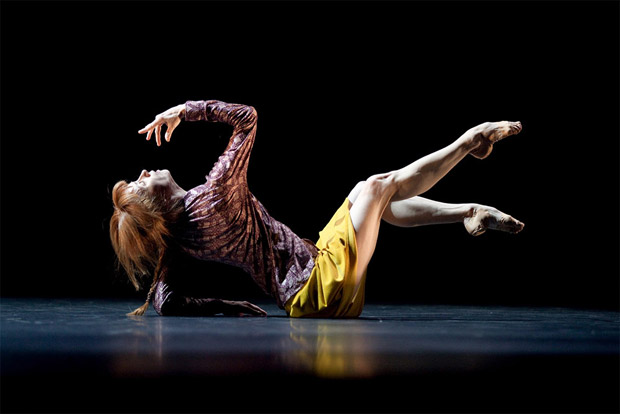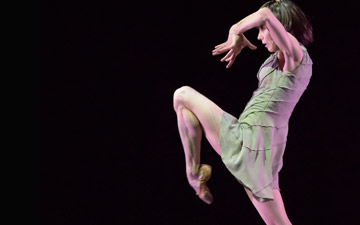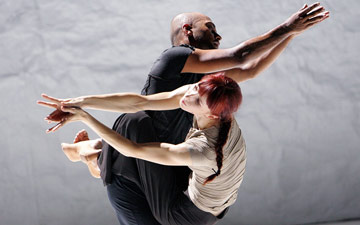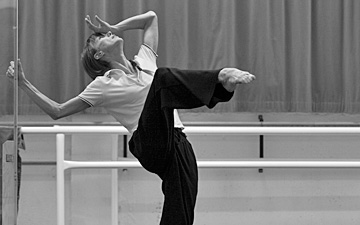
© Lesley Leslie-Spinks. (Click image for larger version)
Sylvie Guillem
A Life in Progress: technê, DUO2015, Here & After, Bye
London, Coliseum
29 July 2015
www.sylvieguillem.com
Sylvie Guillem’s farewell programme at the Coliseum (following its modest Sadler’s Wells presentation in May) is a glorious spectacle in the largest theatre in London. Though it’s her adieu to the capital, she will continue performing Life in Progress to cities around the world until she retires from dancing at the end of December in Tokyo.
At the age of 50, she is making the most of the time left to her as an international star. Unlike her former colleagues at the Paris Opera Ballet or the Royal Ballet, she made no formal farewell performance to ballet in a three-act production, surrounded by floral tributes. (She was genuinely surprised when audience members recognised her last Juliet with the Royal Ballet by giving her an ovation.) She went on to extend her career as a contemporary dancer in her own mould, choosing choreographers and performers with whom she has enjoyed working.
That’s why her last programme is so special. The choreographers are people she has collaborated with over the years: Mats Ek, William Forsythe, Akram Khan and Russell Maliphant. They understand her as a dance artist, a formidable stage personality and a woman with interests outside the theatre. They also understand, as dancers themselves, how fleeting performance can be, how age and injury can impair hard-won physical mastery. All four pieces are concerned with time and memory; circles and spirals keep recurring, endings are never final.

© Gilles Tapie. (Click image for larger version)
Akram Khan’s technê (from the Greek, meaning knowledge based in practice) places her in a magic circle of light with an enchanted tree in its centre. Guillem scuttles round it, keeping low. When she stands to touch a branch, the shock sends her into spasms. Three musicians are revealed in the darkness at the back, accompanying Alies Sluiter’s recorded score. Guillem’s body, dressed in a brief shift, is her own instrument, honed by her classical training. She is so flexible that she appears to sink into the lighted circle when she splays herself flat.
As she explores the space around the tree, she seems a curious child, then a sorceress spinning an incantation, a python goddess ready to strike. At the end, she merges with the delicate wirework tree, whose branches, as it turns on its axis, resemble the shapes her strong, slender limbs make as she dances. Khan has acknowledged that Guillem is indeed a force of nature.
Technê is followed by two duets, one danced by men, the other by women. Forsythe’s DUO2015 was originally created in 1996 for two women, members of his Ballett Frankfurt. They looked glamorous in transparent tops revealing their breasts and black shorts displaying their bare legs. Obviously ballet dancers, they played with Forsythe’s experiments in extreme épaulement, constantly returning to taut tendu positions with their legs, one arm raised in a diagonal salute. It was the sort of Forsythe showpiece that Guillem would have excelled in.
Instead, she leaves DUO to two men, Brigel Gjok and Ridley Watts, both members of the former Forsythe Company. Guillem has moved on, and so has Forsythe. With his agreement, the men wear singlets and baggy trousers concealing the line of their legs and feet. They appear blokey athletes rather than ballet-trained dancers – or maybe break-dancers, competing with new moves or copying each other in counterpoint. They never touch: the emphasis is on their bare shoulders and whirling arms, muscular, sometimes elegant. Since Thom Willems’s score, unusually for him, is barely audible, they cue each other by breath and glances, following intricate pre-determined rhythms. Unlike Merce Cunningham’s dancers, able to do the same thing, they look self-consciously aware of their timing.
Guillem commissioned Russell Maliphant to create a female duet, something she had never danced before. Here & After, for Guillem and Emanuela Montanari (of La Scala Ballet) is a deliberate contrast with Forsythe’s DUO2015. The two women are frequently in contact, pulling against each other’s weight or intertwined to make sculptural poses in slow motion. Andy Cowton’s soundscore, with recorded breaths and sighs, cues them to keep in tune with one another, co-operating instead of competing. Guillem tries to stay inconspicuous under Michael Hulls’s dappled lighting, but although the women look fairly alike, she is always the watchable one.
The choreography relies on synchronised circular movements in the first half of the duet, set on a circle of light. It gives way to squares as the soulful score changes to distorted yodelling and the women undertake larky martial arts manoeuvres. The partnering is hardly challenging, given that Guillem was still performing Push with Maliphant a year ago, with its taxing lifts and falls. Here & After, overtly feminine, seems sentimental in comparison.

© Lesley Leslie-Spinks. (Click image for larger version)
After an interval, Guillem makes her adieux in Ek’s Bye, created for her in 2011. She starts as an Alice in Wonderland, peering through a door (in fact a screen for video images) at the back of the set. She finds a way to clamber into the stage and grapple with her memories and limbs that won’t always do as she asks. She is both girlish and grown-up, pulled in different directions, defiant and conflicted as she knocks on imagined doors or rolls on the floor, howling. She sheds clothes and shoes and identities, while a man – and a dog – appear and vanish on the door behind her. Even when she turns upside down because her head is doing her in, she never looks ungainly in Ek’s quirky choreography.
At last in this programme, she’s moving her eloquent body in response to meaningful music: the Arietta from Beethoven’s last piano sonata, number 32 in C minor. She and the music are resolute, struggling to reach resolution. The video ‘door’ fills with images of people waiting for her. Maybe they are people she had to leave behind during her career, or those she is hoping to find in her next life. She joins them in an ending that is both an acceptance and a question mark: an end or a beginning.
Funny, perplexing and touching now, Bye will be unbearably poignant when Guillem finally performs it for the last time. Paradoxically, for such a personal piece, it works even better in a large theatre than a more intimate one. Guillem grew up and flourished on opera house stages. They are where she should bid her farewells, even as she leaves, of her own choice, for a more private life. We are indeed lucky to have experienced her.

















You must be logged in to post a comment.